“Bouquet Francaise” is the name the @littlebitGerman gave to the Red Francaise after she saw it in person and I think it describes it beautifully. Throughout the bulk of it’s existence, it was just the “red francaise” which is what I’ve called it in previous posts and I’ll leave it as such for ease of finding it.
So during residency, I was working 80+ hours a week, and had very little time to sew/sleep/eat, or much else of anything really. So to reward myself, I told myself I would buy myself 10 yards of any fabric I wanted when I got out. So I did. I rewarded myself with 10 (which eventually became 12) yards of this beautiful Scalamandre Basilica. It is now discontinued which is how I was able to afford it, but remains findable on some incredible sites like silkresource.com
Initially, I was terrified of it. I literally stared at it for four months and could not get myself to cut it. I finally got myself to touch it, by making TWO mock ups before I touched it; one in muslin (no photo) and one in yellow silk taffeta as you can see here:
Photo by Lindsey Hinderer Modern Portraits
Make up by Summer Savannah Beauty
Finally, feeling like I finally could remotely trust myself to not shame myself by cutting the fabric, I started.

I chose to use the JP Ryan pattern as the base; and though I changed the shape of the bodice to accommodate by more modest bosum, otherwise, I kept very close to the original shape.
I started as we often do with any 18th century cutting (as per the Larkin and Smith patterns, which is where I learned to sew more period correct clothing, and reinforced by the American Duchess book) the lining. I actually have a hard time keeping linen from stretching so I elected to use cotton coutil for mine.

One thing that is totally not HA about JP Ryan patterns, but something I absolutely love about them, is the panel that laces up in front. This region is then covered by the stomacher. It does make for ease of dressing since I don’t have a lady’s maid. Not HA, but so is not having a lady’s maid so… I think it evens out. 🙂 It does promise a great fit and smooth sides once I put on the gown, even in a rush!
PS: You’ll notice my totally HA doggy (a little Rescue Eskie named Elspeth) in the picture. She loves photobombing everything I do. One thing I LOVE about American Eskimos is that they were totally the breed of choice for Gainsborough.
And before you start messaging me about whether or not these are pomeranians, compare them to the size of pomeranians and then look at standard American Eskimos. Either way, whatever breed these historically accurate fuzzballs were, I can safely say, my dogs can costume them to perfection!
Well, in any case, after my lining was complete, I went ahead and started work on the fabric itself. I started on my favorite portion – the Watteau pleats!
Luckily I have a very lovely and large cutting table so I was able to stretch the fabric out as much as I needed. After an initial center seam (by machine since I do all my non visible seams on a machine… this is where my impatience does present itself.), I started pinning down the pleats.
After these were CAREFULLY pinned on, I then started the process of sewing it down, attaching it carefully to the lining. Sewing down pleats is my FAVORITE part of dress making. This was fun! I sat watching Poldark for hours and pleating.
After sewing on the back portion, I then hand sewed the back to the front, using the method outlined in the Larkin and Smith pattern for English gowns.
At this point, the gown was starting to really look like a gown.
This was the most exciting part! You must understand, up to this point, due to hours of deliberating, staring at the pattern, matching the pattern, trying to get the perfect pleats in the back, I must have spent approximately 30 hours getting to this point. I tell everyone, I am NOT a fast seamstress. But even then, I understood that I was nowhere near the finish line.
But I can’t lie, I was super proud of my Watteau pleats matching up as they did. 😀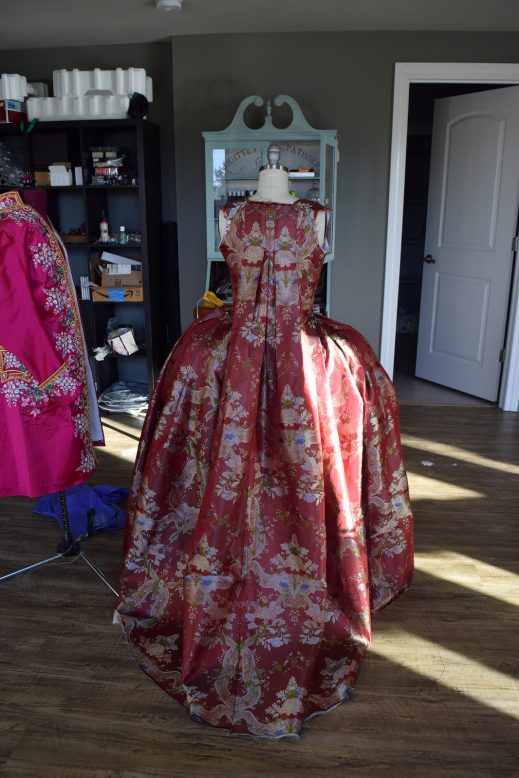
On a slight side note, for the bottom hem of the train, I really didn’t want the lampas to fall apart. Historical gowns have a little bit of white silk or linen sewn to the bottom to keep the lampas from unraveling. I actually elected to use a bit of modern technology to fix my problem. I put about 18″ of iron on horsehair interfacing to the bottom of the hem and train, to protect that lampas as well as keep the train firm as I walked. I suppose I could have used something more HA, but I really didn’t want the seam to of where I sewed the lining on to show up on the outside, which would have been inevitable, no matter how careful the stitches.
(Again, my personal philosophy is embracing the use of modern technology in order to make historical clothing as beautiful as possible. Hence my love of laser cutters, 3D printers, embroidery machines… But I’m a technology junky at heart. This is why I either costume 18th century…. or 40,000 years in the future. Also I enjoy robotics in my spare time but I don’t plan on going into that on this blog.)
Then sleeves went on, and I was finally able to try wearing it for the first time.
Again, you’ll notice my HA doggies photobombing. 😀
I LOVE wearing this gown! I just love the way the train sweeps after me, and absolutely everything about a Francaise. I really do think that there is no gown-type on the planet more flattering on the average figure than a francaise. No matter your height, body type, etc., a francaise sewn to the right proportions, with the right undergarments is as majestic and flattering as you’ll ever look.
Anyways, this was about… 35-40 hours of my life so far? This was the exciting part.
So, after purchasing the fabric, I had spent about 4 months online shopping for trim. I wanted something in silk, with the warp weave look so common in the 18th century. I finally realized I loved the look of fly trim, but could find nothing that really had the same look as it in modern day. So I elected to weave it myself.
I started off slow; I would say the first two meters took about 24-30 hours.
The initial plan was to make all my trim and then get started putting it on a dress. I had read somewhere that the average francaise took 12 meters of trim. That person was clearly drunk when they wrote it. I made 12 meters and started putting it on my gown. I didn’t even make it to half!
THIS was my 12 meter point. I didn’t even make it around the “swirls” (technically called “furloughs”) around the front of the skirt! It was laughable how wrong they were. In any case, I just kept going, and at that point, I had sped up to the point where each meter took me approximately 8 hours instead of the initial 12 – (including the time knotting the fly trim, cutting them to the right length, fluffing them up with a tooth brush, collecting them, fighting my dogs for them when they decided that eating silk fluffs was fun, and then refluffing the flys, and then weaving it).
As for the stomacher, I was aiming to have it look like the one from at the Museum of Victoria and Albert.
So I placed my 1″ trim very similarly to the stomacher on the right (despite the fact that my stomacher was distinctly less triangular…) and did my best.
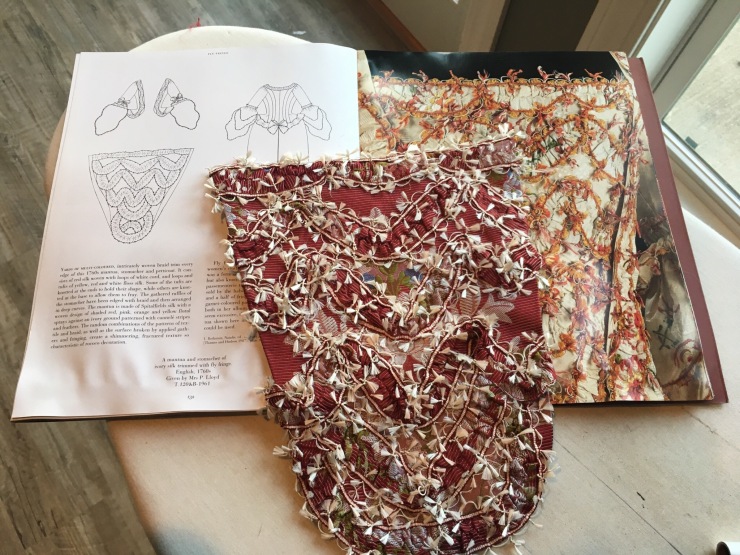
Before I even finished, I had a photo session scheduled with the INCREDIBLE Lindsey Hinderer (can’t recommend her enough), and I couldn’t resist snapping a few photos.
Random aside: I really can’t emphasize how important it is to work with a photographer who understands your vision and has the same aesthetic as you. Lindsey knew that I wanted to look like an 18th century portrait and she really delivered.
Photo by Lindsey Hinderer Modern Portraits
Make up by Summer Savannah Beauty
I was shocked at how much I loved the historical makeup I picked up from Little Bits on Etsy. I can say I honestly never would have thought of it, but it was a thoughtful present from my sister in law. Since then, I’ve picked up a bunch more HA makeup! Her pomade is a must have.
From here on in, I just continued towards the finish line. Please note that since October when I started this, this was one of two projects I was working on. Fly trim alone, I think I spent about 300 hours weaving.
I added a third sleeve ruffle (here is where the American Duchess book saved my life! It was INCREDIBLY helpful here! No one else has such nuanced and helpful instructions. And trust me, I looked everywhere!). I changed up my petticoat to have a smoother front panel. I added fly trim EVERYWHERE. At the end, I think I used about 36 meters of fly trim. Again, 12 meters my ass.
After all this, this is the gown I came up with, as photographed by the incomparable Lindsey Hinderer.
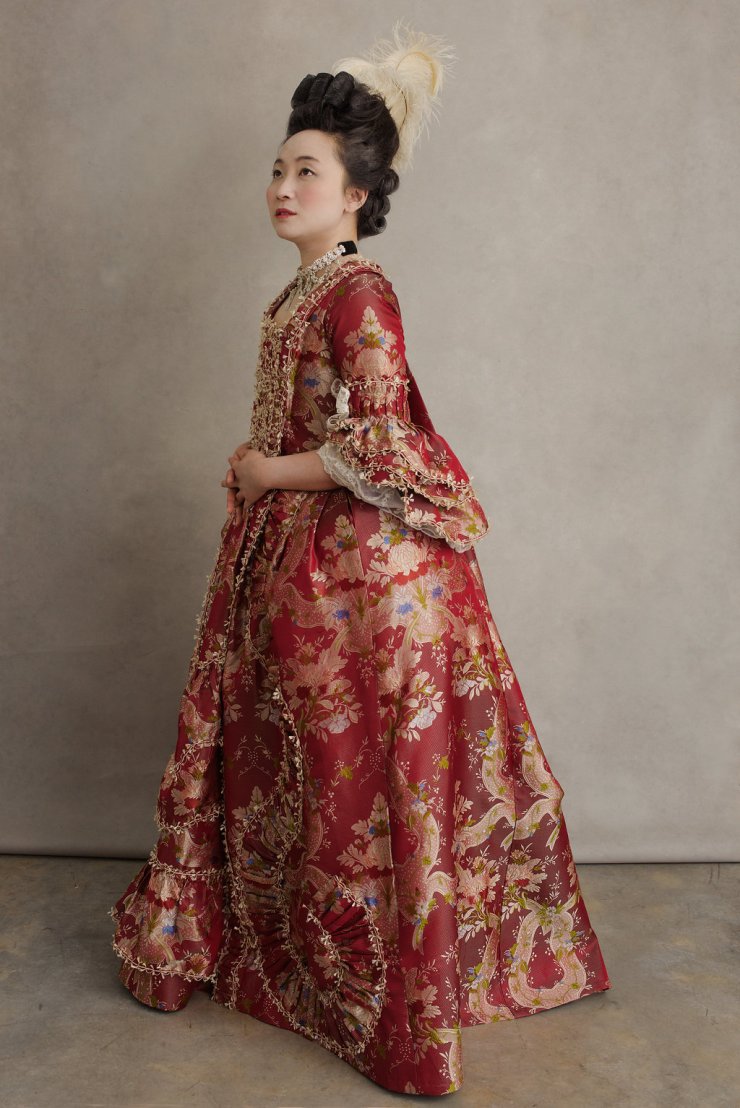


Photo by Lindsey Hinderer Modern Portraits
Make up by Haley Hansen Makeup
Lindsey was kind enough to take some detail shots for me.
I had some truly amazing accessories:
- Shoes by Agustin Moreno
- Necklace by Queen and Cavendish
- Stockings by American Duchess
- Makeup by Little Bits Historical
- Hair pieces by Jenny La Fleur
And with this outfit finished, we headed off to Paris for Fetes Galante at Versailles.
It was an absolutely fabulous time! I did have to leave an hour early due to my nausea, but overall, it was still incredible.
In any case, this is the story of my francaise and adventures with fly trim! Do post if you have any comments or questions about trim making.











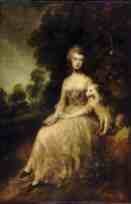




















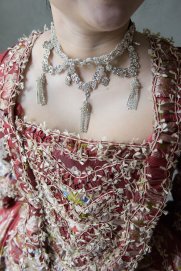












HOLY GUACAMOLE! this is so fantastic, you are incredibly talented, you look absolutely stunning! so many exclamation points!!! 😀
LikeLiked by 1 person
Thank you so much! 😀
LikeLike
Wow. I am stunned by your level of expertise, especially given that it appears (based on your comments re “residency”) that you are also a physician. I have so much admiration for your commitment! And, of course, the outfit is absolutely EXQUISITE.
LikeLike
Hi Susan! Yes, I am a physician as my day (and night) job. I think it’s so important for doctors (and everyone really) to have a hobby outside of work. Particularly in medicine, what we do is so emotionally charged and challenging, that coming home to do something completely different is actually an emotional release. It’s kind of funny – I think every physician I know has a passion outside of medicine, be it flying hover crafts, pro-golf-tournaments, globe trotting, or flying mini-planes. Thank you so much for looking! 😀
LikeLike
You are absolutely brilliant. You look like you just walked out of the 18th century. I am so very impressed with your work.
LikeLike
Just beautiful – you look exactly as if you’d stepped down from a portrait!!!!
LikeLike
I am speechless! All I can say is: SUPERB!
LikeLike
Wow. Inspiring
LikeLike
I’ve studied historical fashion for over 40 years and I thoroughly enjoyed reading this and seeing the photos.
LikeLike
Well done. Oh, the fly fringe!
LikeLike
WOW! What a fantastic job you did. Everything is to perfection. Thank You for sharing.
Marion
LikeLike
I am so impressed by your talent. You did such a fabulous job. You look like a lady of that century.
Marilyn
LikeLike
Your gown is just amazing!!! Beautiful! Are your dogs American Eskimos? I used to have one and it was such a nice surprise to see them pop up while I was reading about your gown.
LikeLike